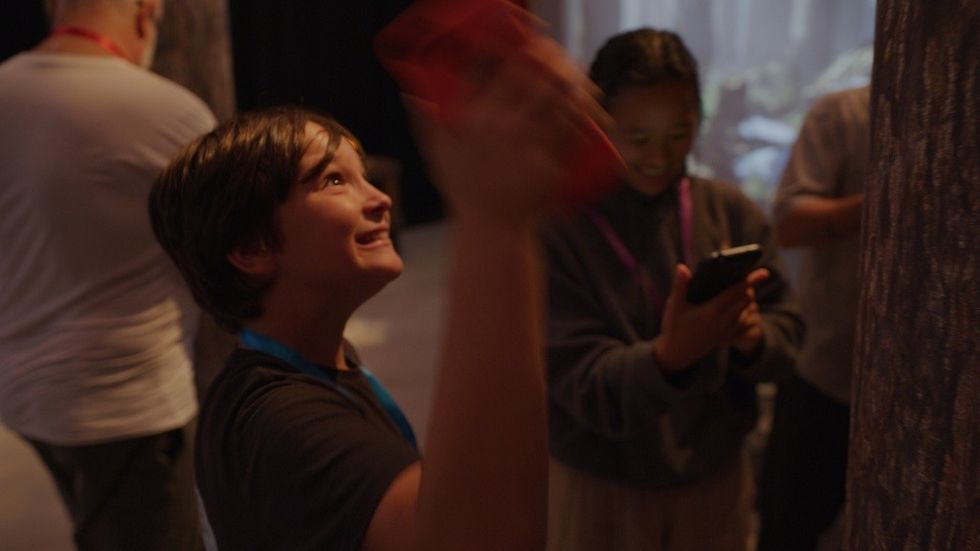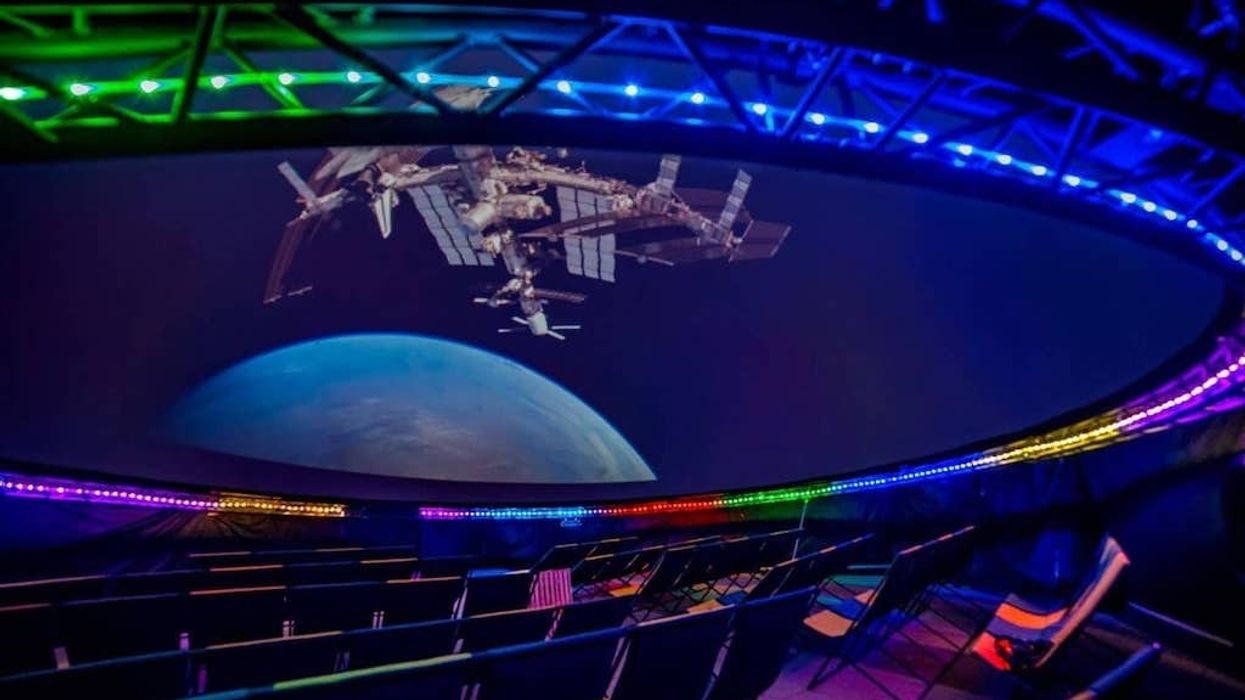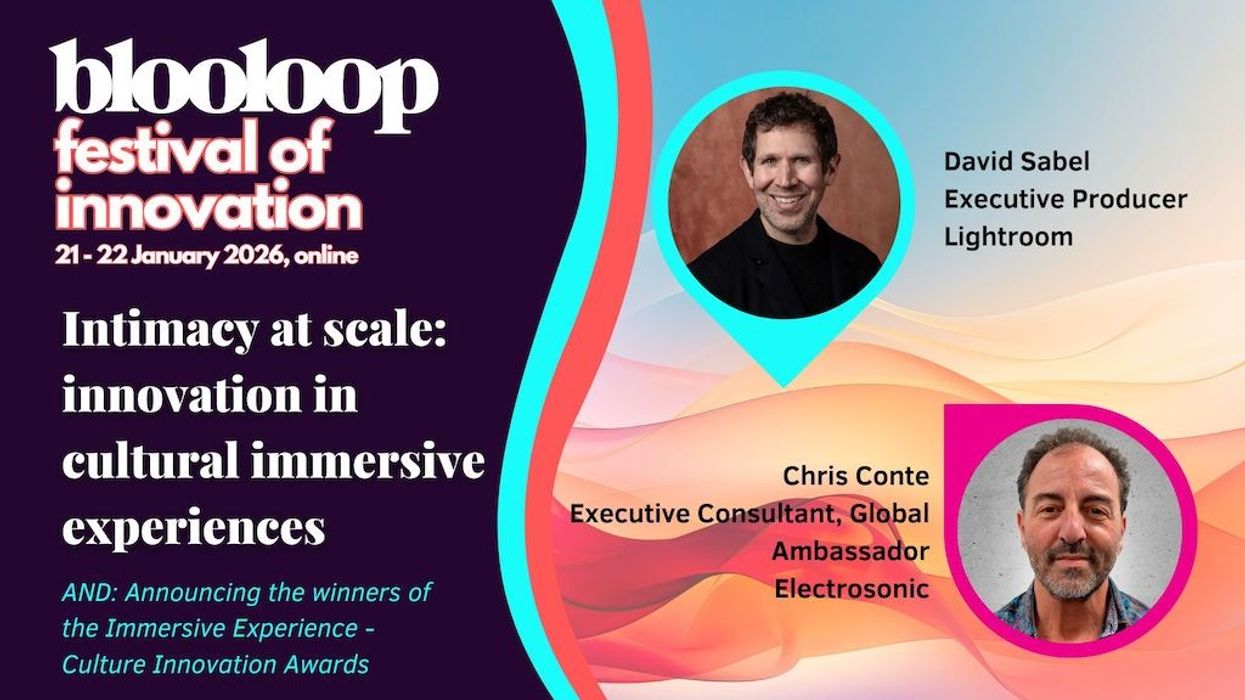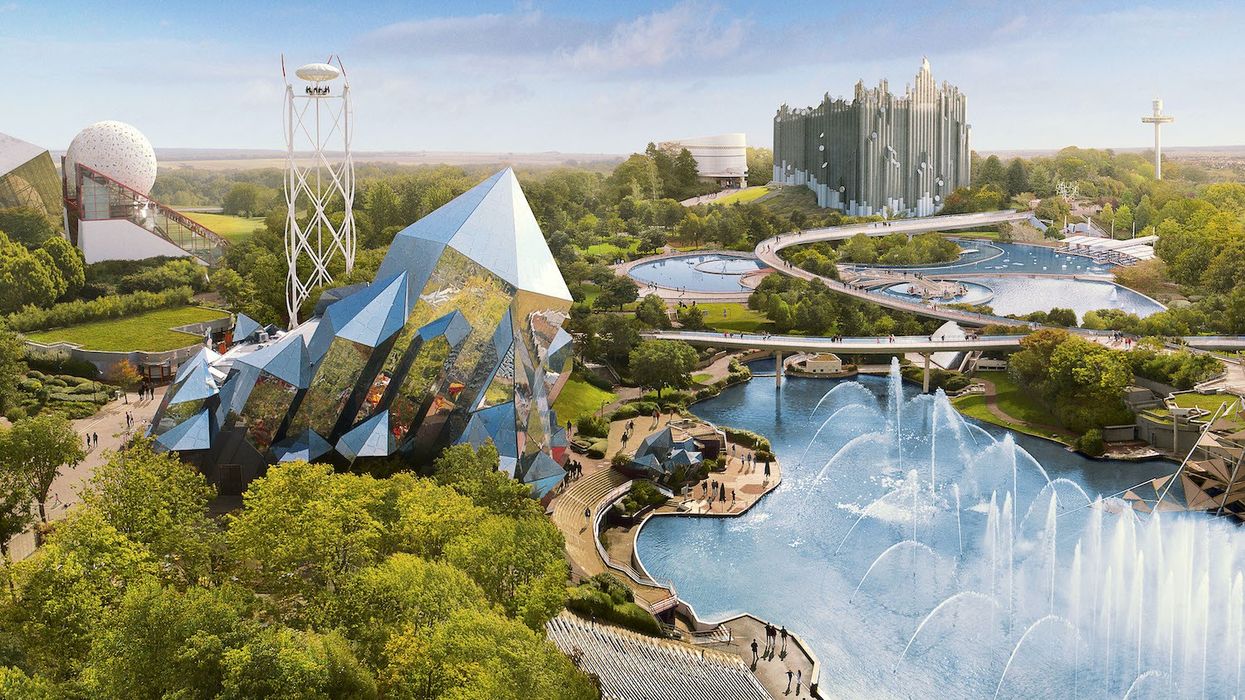4elements, a Montreal-based multimedia design studio founded in 2016, is at the cutting edge of experiential design, offering immersive, interactive experiences that combine technology, storytelling, and physical engagement. A core aspect of the company’s mission is a commitment to uniting people with transformative, gamified experiences that go beyond traditional entertainment.
We speak to co-founders Valerie St-Jean, managing director, and Simon Coulombe, director of technology, about how the firm is leveraging innovative technologies and compelling stories to captivate audiences in museums, theme parks, and other entertainment venues worldwide.
The 4elements vision
4elements works on playful, immersive, and interactive experiences, and it creates projects across the visitor attractions sector, including museums and immersive, as well as retailtainment, brand activations, and more.
“We wanted to transform the way people experience interactive multimedia, blending the digital and physical worlds to create an immersive, memorable experience,” says St-Jean, an entrepreneur passionate about technology and human interaction, speaking about the studio’s founding mission. “We wanted people to play active roles, not be passive observers. For us, it is important that people have a say in the experiences they live.”
The idea behind 4elements was born from a shared passion for crafting impactful, engaging experiences. St-Jean and Coulombe identified a rising interest in interactive and immersive entertainment, especially among younger audiences who prioritise experiences over possessions. St-Jean says: “Gen Z and millennials don’t want just to buy things—they want to live experiences.”
4elements set out to integrate digital technology with real-life interaction, allowing people to connect with each other and engage more with content in shared spaces.
“Our goal has always been to bring video game elements into real-world settings,” adds Coulombe. “4elements specialises in gamification, creating experiences where people are not just spectators but active players. We can develop turnkey solutions for clients, creating the scenario, story, content, and technology, and we also develop our own IP.”
Spark: a proprietary game engine
This foundational principle inspired the development of Spark, 4elements' proprietary game engine.
Spark empowers the team to design flexible, immersive environments across diverse platforms. It not only drives the company’s projects but also provides a basis for client collaborations, facilitating the smooth integration of technology with storytelling and interactive design.
“We developed a gaming engine that allows us to iterate quickly and gamify any space. We can leverage this advanced gaming engine Spark in our interactive storytelling and multimedia production to bring a location to life, whether it's a park, a museum, or cultural or location-based entertainment,” says St-Jean.
“It's the tool that allows us to connect all the different aspects and multimedia elements, such as the projections, the lighting, interactive props, and scenery,” says Coulombe. “Everything is connected through that platform.”
Gamification from 4elements
4elements’ unique approach to immersive entertainment can be seen in one of its most recent standout projects, Timber! The Forgotten Legends. Timber, which first opened to visitors in Montreal in 2023, is a nature-centred experience exploring art, culture, and the beauty of the natural world.
Visitors embark on a guided journey through a woodland filled with large-scale props and scenery, where they can cut down giant pine trees, drive logs along river rapids, forge advanced tools, cook meals, brew potions and remedies, and even encounter werewolves.
Timber immerses guests in a multi-sensory setting with interactive props, live performers, and large-scale video projections. As they enter an open space with floor-to-ceiling video displays, participants feel they have stepped directly into a video game.
“Timber was a breakthrough project for us,” Coulombe. “We wanted to create a game-like experience, but in real life. People can chop virtual trees with physical props or drive logs down a river, all while interacting with other players and characters in a shared space.”
The environment comes alive with digital elements that react to players’ actions, as the Spark engine synchronises players’ movements and interactions with the multimedia visuals around them.
An evolving story
When people come to the space, they download the app and choose a character, and a group of about 30 people plays simultaneously. Different people will have different roles, and they explore the environment and engage in various activities.
“They encounter virtual characters who can give players clues on what to do, and there are also real performers in the space, in costume. It is close to the level of narrative and interactivity you would find in a video game, but it's set in a real-life context, with real people connecting and becoming the heroes of their own adventure.”
Timber! shows how the studio works to create experiences that resonate on both personal and universal levels. By developing a project that tailors itself to players’ decisions, 4elements can offer a unique experience for each participant.
“Some people came back to Timber multiple times, and each time, they lived a different experience,” says St-Jean. “The story evolves with each interaction, which is something people really appreciate.”
Making the content come alive
4elements has partnered with museums, tourist venues, location-based entertainment producers and cultural institutions to bring this game-inspired approach to the world of exhibitions.
For example, it produced the temporary exhibition The Canoe, Bearer of Traditions at the Huron-Wendat Museum in Quebec City, which explored ancestral skills related to cedar canoe-making.
Visitors were invited to step into the workshop and learn about the canoe’s history, the various manufacturing methods used in Wendake, and the oral traditions shared by the elders regarding the cedar canoe. They could also engage with the topic through a virtual quest.
Meanwhile, for The Queen's Ball, a Bridgerton Experience, 4elements developed a painting studio where guests could have their picture taken in a decor inspired by the Netflix series.
Using interactive easels, they could transform their photo into a painting, add a few personal touches and share it on social media. The guests' pictures were also displayed in real-time on picture frames scattered across the event's space. The experience travelled through 10 cities worldwide, and more than 120,000 people were able to share a memorable moment thanks to 4elements technology.
Cosmodôme and more
Elsewhere, 4elements developed Abstrak, an interactive version of André Boucher 's artwork Univers chiffonnés. This invited people to continually transform the work through interactions, fostering a deeper connection with the artist's creative approach. Showcased in Montreal and Brussels as a travelling exhibition suitable for different venues, the Abstrak project featured three interactive areas where visitors could customise colours, textures, and reliefs, effectively co-creating a unique piece.
Other projects include an interactive game created for SÉPAQ's national parks, enabling visitors to learn more about the flora and fauna. Another highlight is a playful interactive installation showcased at the Louvre-Lens in France, where attendees were invited to play with fire, literally, as part of the Fêtes de la Sainte Barbe.
The studio’s latest project is renewing the permanent exhibition at the Cosmodôme in Laval. Dating back to 1994, the Laval Cosmodôme aims to enhance public enthusiasm for space exploration, scientific education, and careers in astronautics. The updated interactive gamified exhibition will invite visitors to embark on space adventures, assume the role of astronauts, and explore the cosmos.
Coulombe describes this project as a natural extension of 4elements' mission:
“Cosmodôme is a place where people can be the heroes of their own space adventure. It’s a massive production, but it remains true to our roots in making immersive experiences accessible.” This exhibition is scheduled to open in November of this year.
The 4elements design process
4elements’ design approach is both adaptive and collaborative. When designing for clients, 4elements engages in a co-creation process, working closely with the client’s team to ensure the design meets their goals and resonates with their audience.
Coulombe says: “Clients usually come to us with a rough idea. The first part of the process is creating the script and storyboard for the experience and validating it with them; most of our clients are hands-on. They're also involved in the design, so it's a co-creation process in which we work with them to develop the experience based on their clientele as well as their communication and financial objectives. Once that is approved, we will start the production. We do most of the content, all of the applications, and most of the technological tools in-house.”
At 4elements, the process is iterative and fundamentally collaborative. To bring a concept to life, the team often needs to create new tools or adapt current technology. This is where Spark, the in-house gaming engine, comes into play. It enables the team to quickly customise interactions to fit the project’s needs.
This adaptability sets 4elements apart in the industry. Its design approach focuses on seamlessly blending content, technology, and physical interaction into an integrated experience. The company wants not just to entertain but to create memorable, multi-dimensional experiences that resonate with its audience.
Responding to industry trends at 4elements
4elements’ growth has been fuelled by its ability to anticipate and adapt to immersive entertainment and experiential design trends.
St-Jean highlights that, as audiences increasingly seek interactive and personalised experiences, the demand for gamified environments has only grown stronger: “We see that people are looking for more engaging experiences—something that feels unique to them and allows them to participate actively, becoming the heroes of their own adventure.”
The team’s method reflects this trend by fostering shared, communal experiences rather than isolated ones. Unlike traditional virtual reality, which often isolates users in separate spaces and headsets, 4elements prioritises physical engagement and social interaction. For instance, Timber motivates players to work together and communicate, turning it into both a social and personal experience.
Coulombe anticipates that this trend will continue as audiences become increasingly accustomed to immersive experiences across various forms of entertainment.
“People want to experience things together, to connect with real people in a shared space,” he says. This insight into audience preferences guides 4elements as it seeks to expand its reach across new markets, particularly in the United States.
What’s next for 4elements?
With its expansion to new markets in the US and beyond, 4elements sees potential in various venues, from museums and zoos to theme parks and aquariums. St-Jean is confident that Spark’s adaptability will be a significant advantage when collaborating with new partners: “Spark can adapt to different types of venues, so whether it’s a museum or a theme park, we can bring gamification in a way that is engaging and immersive.”
Looking further ahead, St-Jean and Coulombe see even more significant potential in pushing the boundaries of user engagement and immersive storytelling. For St-Jean, the ultimate goal is to connect people through shared experiences, fostering an environment where everyone can be the hero of their own adventure.
Coulombe, meanwhile, is driven by the challenge of developing new technology to make these experiences possible. “For me, it’s about solving problems,” he says. “Each project is an opportunity to build something that didn’t exist before.”
This progressive outlook embodies 4elements’ broader vision for experiential design. They foresee a future where experiences become more interactive and personalised, empowering users to craft their own stories. With contemporary audiences eager to control their experiences and see the effects of their decisions, 4elements is at the forefront of this trend, designing experiences that adapt in real-time to participants’ choices and actions.
Embracing innovation
4elements stands out not just for its technology but also for its storytelling approach. Timber and Cosmodome demonstrate how 4elements creates immersive worlds where participants take on active roles in their adventures. According to St-Jean, this focus on engaging, adaptable storytelling sets 4elements apart. “We are people connectors,” she says. “We want people to return and experience something fresh with every visit."
With Spark, 4elements continues to push the envelope, developing more sophisticated ways for participants to interact with both digital and physical worlds. By focusing on adaptability and real-time feedback, 4elements is pioneering a new approach to experiential design that is both inclusive and transformative.
With a dedication to innovation as well as a distinctive approach to experiential design, the studio is transforming our interactions with stories, spaces, and each other. Its evolution from a small team to a leader in gamified entertainment showcases its enthusiasm for crafting immersive, engaging, and deeply memorable experiences. As the firm continues to broaden its reach and enhance its technology, it will enable visitors to connect, engage, and discover the world in fresh and exciting ways.
Charlotte Coates is blooloop's editor. She is from Brighton, UK and previously worked as a librarian. She has a strong interest in arts, culture and information and graduated from the University of Sussex with a degree in English Literature. Charlotte can usually be found either with her head in a book or planning her next travel adventure.
















 TM Lim and Adam Wales
TM Lim and Adam Wales









 Toby Harris
Toby Harris Hijingo
Hijingo Flight Club, Washington D.C.
Flight Club, Washington D.C.
 Flight Club Philadelphia
Flight Club Philadelphia Flight Club Philadelphia
Flight Club Philadelphia Bounce
Bounce Hijingo
Hijingo Bounce
Bounce
 Fernando Eiroa
Fernando Eiroa











 Nickelodeon Land at Parque de Atracciones de Madrid
Nickelodeon Land at Parque de Atracciones de Madrid Raging Waters
Raging Waters  Mirabilandia's iSpeed coaster
Mirabilandia's iSpeed coaster Parque de Atracciones de Madrid
Parque de Atracciones de Madrid Ferracci at the ribbon-cutting ceremony for Nickelodeon Land at Mirabilandia, with (left) Marie Marks, senior VP of global experiences for Paramount and (cutting the ribbon) Sabrina Mangina, GM at Mirabilandia
Ferracci at the ribbon-cutting ceremony for Nickelodeon Land at Mirabilandia, with (left) Marie Marks, senior VP of global experiences for Paramount and (cutting the ribbon) Sabrina Mangina, GM at Mirabilandia Tropical Islands OHANA hotel
Tropical Islands OHANA hotel Elephants at Blackpool Zoo
Elephants at Blackpool Zoo  Tusenfryd
Tusenfryd
 Andrew Thomas, Jason Aldous and Rik Athorne
Andrew Thomas, Jason Aldous and Rik Athorne







